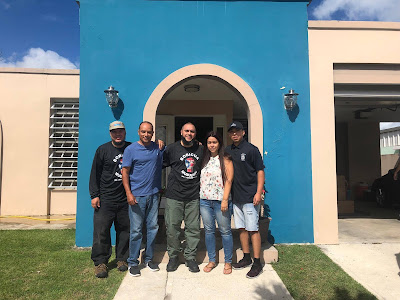Today was a day filled with blessings and life-changing experiences. We started our day by heading to Adjuntas to see my family who lost their 17-year-old daughter just 5 days ago due to leptospirosis, a bacterial infection originating from the urine of rats and other infected animals. Due to the poor living conditions in Puerto Rico after Hurricane María, characterized by debris and garbage littering the roads and residential areas, these types of diseases are becoming more common in many areas on the island.
Besides seeing my family, giving them my sincerest condolences while hugging and embracing them, the purpose of our trip was also to pay for the entire funeral costs with money donated by the Muslim community. When I had informed my cousin previously over the phone that the Muslim community would cover the funeral expenses for his daughter, he immediately broke down crying while expressing his gratitude to the Muslims and the 3 Puerto Rican Imams Project for their assistance in this time of need.
We met my cousin in the plaza of Adjuntas and he invited us to breakfast. While having breakfast we saw the true Puerto Rican spirit of love, compassion, and empathy as various people approached him to offer their condolences, to hug him, and let him know that they are there for him and his family to offer their help should if needed. It was absolutely amazing to experience this.
We proceeded to the funeral home, “Funeraria Carmen Memorial,” to pay for the funeral costs and the people there were friendly, sweet, and extremely flexible. When I had called the administrator the day after my cousin died to ask if they would wait to receive the payment a week later when I arrived in Puerto Rico, they responded positively without hesitation.
At that moment, the administrator quickly informed me that they would handle the entire process and take care of the family’s needs without making them wait until I could bring the check a week later for the services they would render. Meeting these people in person while thanking them for this spectacular service was an enormous highlight of my day and something that taught me that great people still exist in this world. After we heard beautiful stories about my cousin by those who knew her, we then visited my cousin’s home to meet with the rest of the family. Imam Yusuf and I sat with them for a couple of hours listening to them and experiencing the beauty of our culture. We then gave them from the food donations for an event that was going to take place in their church the following day for those affected by Hurricane María. Again, they were extremely happy that further assistance was being provided to them and their town.
We drove back to Casa Taller where we met up with the AgitArte crew and loaded the van to head to the “Pedro Albizu Campos Community Kitchen” in La Perla, Old San Juan. This neighborhood, made famous by the music video for “Despacito,” the international hit single by Puerto Rican performers, Luis Fonsi and Daddy Yankee, became a touristic destination for those foreigners who wished to tread the beachside, winding sidewalks and color-splashed views. However, the “pearl” of San Juan was forgotten from one day to the next after Hurricane María wreaked havoc, leaving its residents without electricity or aid to clean up its streets. Aid to this sector has been just as "despacito" (slow) as the song's title.
(Image from http://promotionmusicnews.com/despacito-neighborhood-destroyed)
This community kitchen sets up three days a week to serve food to the people of La Perla. When we arrived, we unloaded all of the items and joined the crew and other volunteers who were preparing the food to serve to those who would come to eat and relax in a safe space. I asked one volunteer named Juan if I could walk with him to deliver the plates of food that they made for the elderly who live in Old San Juan and he replied in the affirmative. I walked with him and another volunteer and I experienced what being a mercy for our elderly was firsthand. It was inspiring, moving, and emotional (watch here: https://www.facebook.com/3PuertoRicanImams/posts/1963677223874079)
After that, Sugeily from AgitArte, along with her crew performed a “Papel Machete,” which is a form of art that brings awareness to the corruption that is happening here on the Island of Puerto Rico, as well as in other places. They performed a very powerful piece. It’s a must see! (watch here: https://www.facebook.com/abusumayyahabdurrazzaq.lebron/posts/1819699638043038)
Soon thereafter there was a second performance that was educative and interactive regarding the history of “La Bomba” Dance. This performance taught us about its roots, significance, and how to practice it appropriately. It was fascinating to learn a bit of Puerto Rican history in a way that was interactive and entertaining, as well as powerful. Bomba is not just a dance, but a form of communication at one point in history (watch here: (https://www.facebook.com/3PuertoRicanImams/videos/1963668903874911/)
We ended the night by sitting to drink a cup of Puerto Rican coffee while reflecting on the impactful day. It was a day that placed within us a further drive to be beacons of positive, life-changing light for the world and its people! And these were only a few heartfelt lessons we learned from our wonderful people!








Comments
Post a Comment